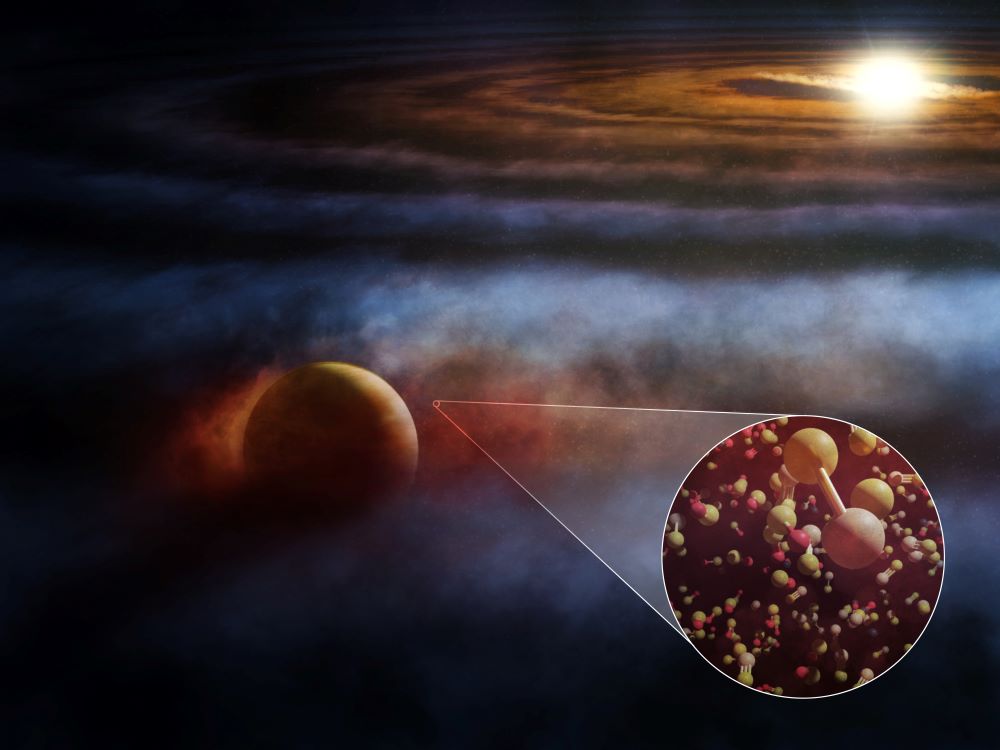Remember how a new car smells? It’s a chemical signature of all the materials used to make the car’s interior. What if you could use chemical signatures to learn about newborn planets?
That’s what a team of scientists did for a recent discovery. They used archival observation data of a protoplanetary disk, made using the Atacama Large Millimeter/submillimeter Array (ALMA). Essentially, they looked for chemical signatures of planet formation around a young star called HD 169142. It has a huge, dusty, gas-rich cloud of material surrounding it that appears to have several planets forming inside. One of those planets is a massive Jupiter-like world called HD 169142 b. That alone makes it a compelling object for study, but astronomers wanted to know more about it and its birthplace. So, they focused ALMA on it and found some amazing chemical signatures related to the gas giant.
Looking for Planets and Finding Chemical Signatures
“When we looked at HD 169142 and its disk at submillimeter wavelengths, we identified several compelling chemical signatures of this recently-confirmed gas giant protoplanet,” said Charles Law, an astronomer at the Center for Astrophysics | Harvard & Smithsonian. “We now have confirmation that we can use chemical signatures to figure out what kinds of planets there might be forming in the disks around young stars.”
This is quite different from the usual approaches to searching out exoplanets. Astronomers can look for them by simply searching for visual evidence. But, the view of small exoplanets gets blotted out by the glare of their star. Oftentimes, the larger ones can be spotted. Another approach is to look for the gravitational influences of exoplanets on their stars (the radial velocity method). However, these aren’t so helpful when it comes to finding protoplanets forming around young stars. That’s because they’re often hidden by their birth crêches. So, you need a different approach, using radio and submillimeter telescopes.
ALMA has often been used to study the protoplanetary disks where new worlds are thought to be forming. So, using chemical signatures of molecules that ALMA can detect is a promising new way to find these baby worlds.

Shock Waves Also Reveal More About a Newly Forming Planet
Law and a team of scientists focused ALMA on the HD 169142 system because the Jupiter-sized planet gave them an alternate way to detect and understand it and possibly other planets forming in the cloud. Since it’s a gas giant, they suspected it would have a detectable chemical signature. The measurements traced carbon monoxide (both 12CO and 13CO) and sulfur monoxide (SO). Those are fairly common and have been found at protoplanets in other disks. So, the team was on the right track.
But, they found something else that surprised them: emissions from a molecule called silicon monosulfide (SiS). This was the first time it had ever been detected in such a disk and came as a surprise. That’s because for it even to be detectable by ALAM, SiS emissions are caused by shocked dust grains releasing their silicate content. They do that when they’re hit by massive shock waves created by collisions with gas that is traveling at high rates of speed. What causes the gas to travel like that? Outflows are somehow driven by giant protoplanets.
“SiS was a molecule that we had never seen before in a protoplanetary disk, let alone in the vicinity of a giant protoplanet,” Law said. “The detection of SiS emission popped out at us because it means that this protoplanet must be producing powerful shock waves in the surrounding gas.”
Opening the View of Planet Formation
This domino effect beginning with outgassing from a giant planet forcing emissions is a useful find. It actually opens a new window on the protoplanet-forming process. It’s not just that it can show the presence of a planet inside a dense birth cloud. It also provides a new way to look at existing planets and their effect on the cloud itself. And, searching out planets via chemical signatures forges a link between newborn worlds and the exoplanets we already know about.
“There’s a huge diversity in exoplanets and by using chemical signatures observed with ALMA, this gives us a new way to understand how different protoplanets develop over time and ultimately connect their properties to that of exoplanetary systems,” said Law. “In addition to providing a new tool for planet-hunting with ALMA, this discovery opens up a lot of exciting chemistry that we’ve never seen before. As we continue to survey more disks around young stars, we will inevitably find other interesting but unanticipated molecules, just like SiS. Discoveries such as this imply that we are only just scratching the surface of the true chemical diversity associated with protoplanetary settings.”
Disk searches for newborns hidden in their creches have resulted in a handful of new discoveries. That’s why this new tool will be so useful. It now gives astronomers another way to look for planets they can’t find using the usual search methods. The science team, headed by Law, has submitted a paper about this method to the journal Astrophysical Letters, for future publication. The tool should open up the search for exoplanets and expand our current population of known worlds beyond the 5445+ already known, and the 9,714+ candidates still to be confirmed.
For More Information
A Surprise Chemical Find by ALMA May Help Detect and Confirm Protoplanets

